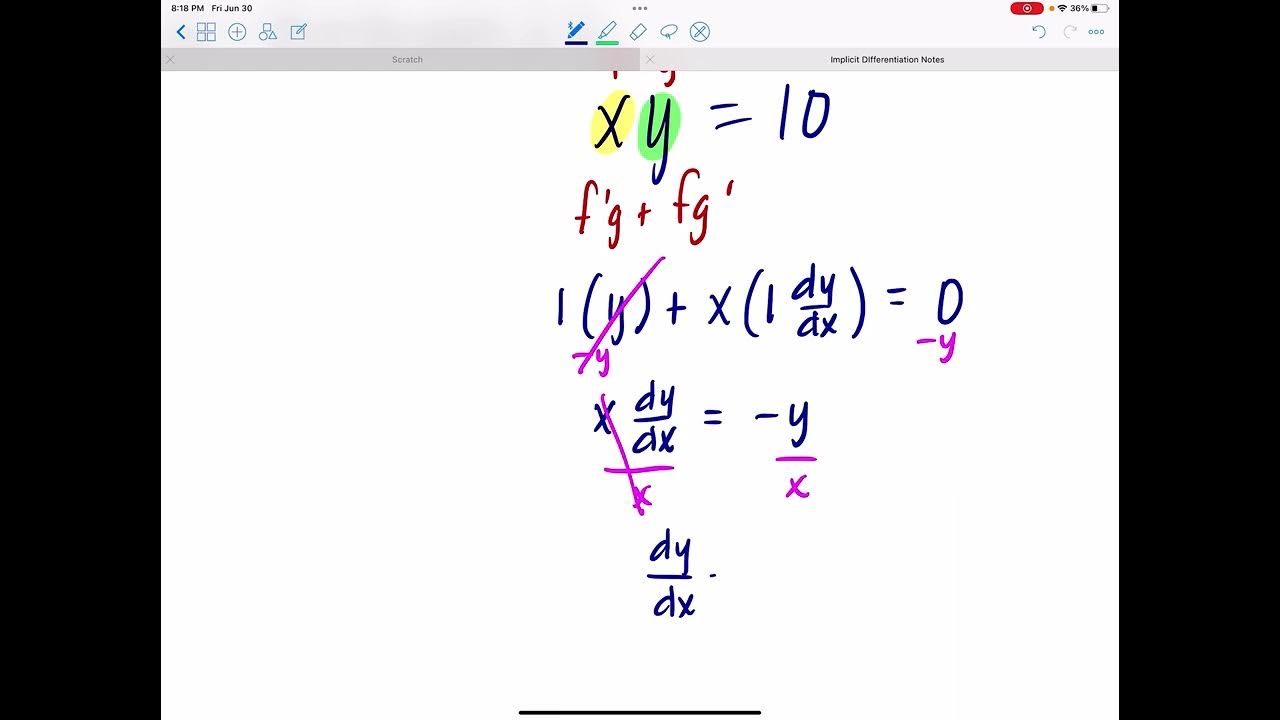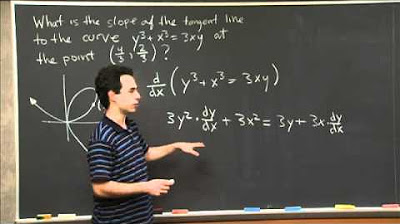Implicit differentiation | Advanced derivatives | AP Calculus AB | Khan Academy
TLDRThis video explores the concept of determining the slope of the tangent line at any point on a unit circle, described by the equation x^2 + y^2 = 1. It addresses the challenge of the circle not being a function of x by introducing implicit differentiation as a solution, avoiding the need to explicitly define y as a function of x. Through the application of the chain rule and the derivative operator to both sides of the equation, the video meticulously explains how to arrive at the derivative of y with respect to x, ultimately solving for the slope of the tangent line at any point on the circle. The example concludes with calculating the slope at a specific point on the unit circle, demonstrating the practical application of implicit differentiation.
Takeaways
- 📐 The given equation x^2 + y^2 = 1 represents a unit circle, plotting all points that satisfy the relationship.
- 🔄 To find the slope of the tangent line at any point on the unit circle, one does not need to explicitly define y as a function of x.
- 📈 The method used to find the slope is called implicit differentiation, which leverages the chain rule without directly expressing y in terms of x.
- 🤔 Initially, one might be tempted to split the unit circle into two functions, considering both positive and negative square roots of (1 - x^2).
- 🧠 Implicit differentiation allows us to apply the derivative operator to both sides of the equation without defining y as a function of x.
- 👓 The derivative of the sum of two terms is the sum of their derivatives, which simplifies the process of finding the slope of the tangent line.
- 📚 The chain rule is applied to the term y^2 by considering it as a function of y and multiplying it by the derivative of y with respect to x.
- 🔢 The derivative of x^2 is 2x, following the power rule, and the derivative of y^2 with respect to y is 2y.
- 💡 The final expression for the derivative of y with respect to x (the slope of the tangent line) is -x/y.
- 🌐 For example, at the point (√2/2, √2/2) on the unit circle, the slope of the tangent line is -1, confirming the correctness of the method.
Q & A
What is the equation of the unit circle mentioned in the script?
-The equation of the unit circle is x squared plus y squared equals 1.
Why can't we consider the unit circle as a function?
-We cannot consider the unit circle as a function because for any given x value, there are two possible y values that satisfy the relationship, making it undefined as a function of x.
What are the two separate functions of x that can be derived from the unit circle equation?
-The two separate functions derived from the unit circle equation are y equals the positive square root of 1 minus x squared, and y equals the negative square root of 1 minus x squared.
What is the purpose of using implicit differentiation in this context?
-Implicit differentiation is used to find the derivative of the slope of the tangent line at any point on the unit circle without explicitly defining y as a function of x.
How does the chain rule apply to the derivative of y squared with respect to x?
-The chain rule applies by taking the derivative of y squared with respect to y and multiplying it by the derivative of y with respect to x, since y is changing with respect to x.
What is the expression for the derivative of y with respect to x on the unit circle?
-The expression for the derivative of y with respect to x on the unit circle is negative x over y.
What is the slope of the tangent line at the point (sqrt(2)/2, sqrt(2)/2) on the unit circle?
-The slope of the tangent line at the point (sqrt(2)/2, sqrt(2)/2) on the unit circle is negative 1.
How does the process of implicit differentiation help in understanding the unit circle?
-Implicit differentiation allows us to find the slope of the tangent line at any point on the unit circle without needing to explicitly define y as a function of x, which is useful since the unit circle is not a single function.
What is the significance of the derivative of a constant with respect to x?
-The derivative of a constant with respect to x is 0, as a constant does not change with respect to x.
What is the power rule applied in the script?
-The power rule applied in the script is that the derivative of x squared with respect to x is 2x, which is derived from the power rule in differentiation.
How does the process of solving for the derivative of y with respect to x unfold in the script?
-The process involves starting with the equation derived from implicit differentiation, isolating the term involving the derivative of y with respect to x, and then solving for this derivative by dividing both sides of the equation by 2y.
Outlines
📐 Introduction to the Unit Circle and Implicit Differentiation
The paragraph begins with the introduction of the unit circle equation, x^2 + y^2 = 1, and the challenge of finding the slope of the tangent line at any point on the circle. It is noted that the circle is not explicitly defined as a function of x, leading to two possible y values for each x. The speaker proposes using implicit differentiation, leveraging the chain rule, to find the derivative without defining y as a function of x. The process involves applying the derivative operator to both sides of the equation and using the chain rule to account for the dependency of y on x. The goal is to find the derivative of y with respect to x, which represents the slope of the tangent line at any given point on the unit circle.
🔢 Solving for the Derivative of y with Respect to x
This paragraph delves into the process of solving for the derivative of y with respect to x, which is the slope of the tangent line on the unit circle. The speaker starts by setting up an equation involving the derivative of y with respect to x and solves for this unknown derivative. By rearranging the equation and isolating the term involving the derivative, the speaker arrives at the result that the derivative of y with respect to x is negative x over y. The paragraph concludes with an example calculation of the slope at a specific point on the unit circle, demonstrating that the derived formula yields the correct slope of negative one for the point (sqrt(2)/2, sqrt(2)/2).
Mindmap
Keywords
💡Equation
💡Unit Circle
💡Slope
💡Tangent Line
💡Implicit Differentiation
💡Chain Rule
💡Derivative
💡Power Rule
💡Constant
💡Function
💡Trigonometry
Highlights
The equation x squared plus y squared equals 1 represents a unit circle.
The unit circle can be graphed by plotting all points (x, y) that satisfy the equation.
The circle is not explicitly a function of y with respect to x, as there are two possible y values for any given x.
The concept of implicit differentiation is introduced to find the slope of the tangent line without explicitly defining y as a function of x.
Implicit differentiation involves applying the derivative operator to both sides of the equation and using the chain rule.
The derivative of x squared with respect to x is 2x, following the power rule.
The derivative of y squared with respect to x is found using the chain rule, which involves taking the derivative of y squared with respect to y and multiplying by the derivative of y with respect to x.
The derivative of y with respect to x is expressed as negative x over y, which represents the slope of the tangent line at any point on the unit circle.
The method allows for finding the slope of the tangent line without needing to split the circle into two separate functions.
The process demonstrates the utility of the chain rule in implicit differentiation.
The slope of the tangent line at specific points on the unit circle, such as (sqrt(2)/2, sqrt(2)/2), can be calculated to be -1.
The video provides a clear and detailed explanation of the steps involved in implicit differentiation.
The method can be applied to other equations beyond the unit circle to find the slope of tangent lines.
The approach is particularly useful when dealing with equations where y is not explicitly defined as a function of x.
The video emphasizes the importance of understanding the chain rule and its application in implicit differentiation.
The process simplifies the calculation of the slope of the tangent line by avoiding the need to solve for y as a function of x.
The video serves as an educational resource for those looking to understand and apply implicit differentiation.
Transcripts
Browse More Related Video

Implicit Differentiation | Differentiation when you only have an equation, not an explicit function

Implicit Differentiation - Finding Equation of Tangent Line

Implicit Differentiation

Implicit Differentiation | MIT 18.01SC Single Variable Calculus, Fall 2010

Worked example: Evaluating derivative with implicit differentiation | AP Calculus AB | Khan Academy

Trig functions differentiation | Derivative rules | AP Calculus AB | Khan Academy
5.0 / 5 (0 votes)
Thanks for rating: